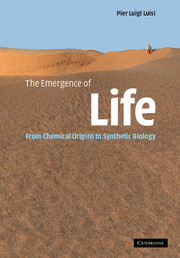Book contents
- Frontmatter
- Contents
- Preface
- Acknowledgments
- List of books on the origin of life
- 1 Conceptual framework of research on the origin of life on Earth
- 2 Approaches to the definitions of life
- 3 Selection in prebiotic chemistry: why this … and not that?
- 4 The bottle neck: macromolecular sequences
- 5 Self-organization
- 6 The notion of emergence
- 7 Self-replication and self-reproduction
- 8 Autopoiesis: the logic of cellular life
- 9 Compartments
- 10 Reactivity and transformation of vesicles
- 11 Approaches to the minimal cell
- Outlook
- References
- Index
5 - Self-organization
Published online by Cambridge University Press: 17 December 2010
- Frontmatter
- Contents
- Preface
- Acknowledgments
- List of books on the origin of life
- 1 Conceptual framework of research on the origin of life on Earth
- 2 Approaches to the definitions of life
- 3 Selection in prebiotic chemistry: why this … and not that?
- 4 The bottle neck: macromolecular sequences
- 5 Self-organization
- 6 The notion of emergence
- 7 Self-replication and self-reproduction
- 8 Autopoiesis: the logic of cellular life
- 9 Compartments
- 10 Reactivity and transformation of vesicles
- 11 Approaches to the minimal cell
- Outlook
- References
- Index
Summary
Introduction
In Chapter 1 we mentioned Oparin's bold idea that the transition to life was based upon a gradual and spontaneous increase of molecular complexity. This ordering process in a prebiotic scenario must have taken place without the intelligence of enzymes and without the memory of nucleic acids, as by definition these did not yet exist. At first sight, this whole idea appears then to be at odds with the second law of thermodynamics and the common belief that natural processes preferentially bring about an increase of entropy/disorder.
As a matter of fact, there are quite a few processes that bring about an increase of molecular complexity, the general term for such processes being self-organization. Some of these processes are under thermodynamic control, i.e., occurring with a negative free energy change; and there are also self-organization processes that are not spontaneous, being under kinetic control.
Together with this increase of structural complexity, another property must be considered – the notion of emergence. Although self-organization and emergence go hand in hand, for heuristic reasons emergence will be discussed in a separate chapter. A particular combination of self-organization and emergence gives rise to self-reproduction, and this will be discussed afterwards.
The terms self-assembly and self-organization are often used synonymously. One might argue that the term self-assembly is more general, and self-organization focuses on those cases of self-assembly that give rise to a significant degree or order (organization). In this text the term self-organization will mostly be used.
- Type
- Chapter
- Information
- The Emergence of LifeFrom Chemical Origins to Synthetic Biology, pp. 85 - 111Publisher: Cambridge University PressPrint publication year: 2006

